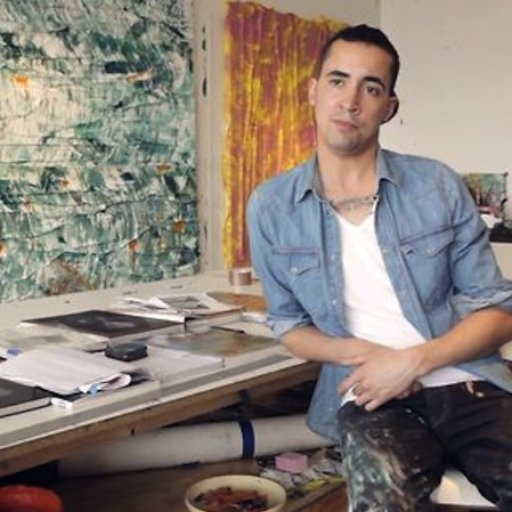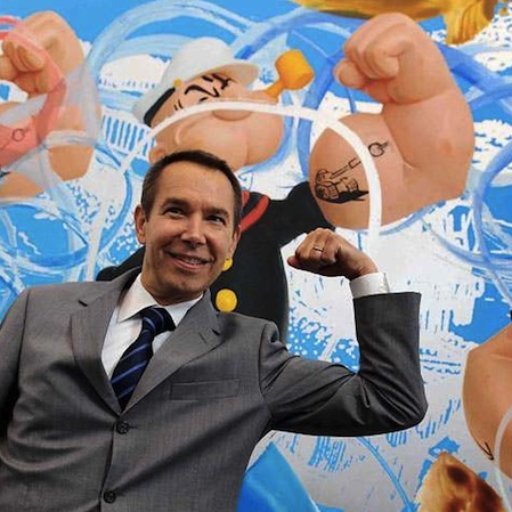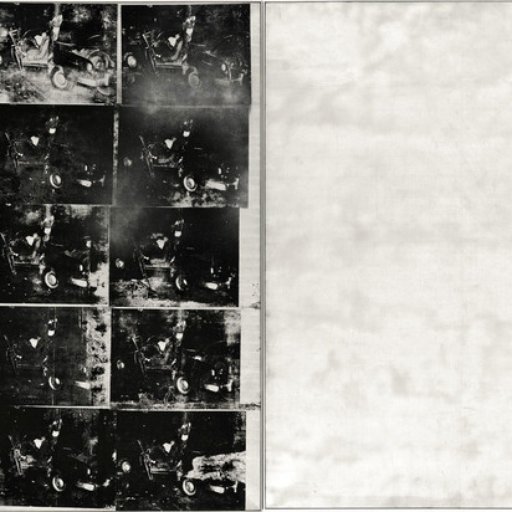The answer is yes and no. Let's begin with why Silicon Valley Contemporary could be a success.
The obvious allure for creating this new fair, and for the 50-some participating galleries to buy in for its first year, is that the tech sphere headquartered in Silicon Valley is generating more wealth more quickly than anywhere else in the world. The nouveau riche of Google, Apple, Facebook, Adobe, and the other industry titans in the area—what Valleywag's Sam Biddle has termed "our coddled new overclass"—have lent the San Jose area a few attention-grabbing distinctions: more patents are filed here per capita than anywhere else in the United States (the government opened a patent office in the city so developers wouldn't have to trek to D.C.), six of the 10 most expensive communities in the country to buy homes are here, and 75 percent of the region's Fortune 500 companies are within 15 miles of the San Jose Convention Center, where the fair took place.
There are other factors at play. The convention center is enormous, sleek, and appealing, superior to the venues available in New York or Miami, and will in fact host the events surrounding the Super Bowl when it comes to neighboring Santa Clara in 2016. The weather is lovely and pacific. There are abundant hotels and restaurants but not a lot else going on culturally, making it perfectly suited to being a trade town. But above all, art dealers are ravenous to tap into this rising class of monied tech industrialists, knowing full well that they are the most significant contenders for being the patrons of tomorrow.
"I think this first fair will inspire people in the area and motivate them to catch the fever for contemporary art," said Rick Friedman, founding director of the fair and head of the Hamptons Expo Group. "We realize this is just the beginning and that we're getting in on the ground floor, so there has to be a learning curve. We're trying to put on an educational program here. But these people are very smart."
So, that is the thinking behind what one New York artist has termed "Nerd Basel." But the only problem is that "these people"—the much-vaunted tech gajillionaire hypothetically interested in collecting art—are a mysterious breed indeed, and dealers are uncertain how to approach them. There were multiple strategies in evidence at the fair.
The Hole Gallery brought drone paintings by Katsu
Several exhibitors tried to connect by speaking the language of tech. At the Hole's booth, the gallery had installed several abstract paintings that the street artist known as Katsu had created by attaching a paint applicator to a small computer-guided drone, with the artist able to control its flight and spray paint on the canvas via a trigger. The idea was that the choppy effects of the drone's propellers and its programming to continually recalibrate its position in the air lent the paintings a collaborative nature, since the artist could not totally control the finished product. (Think Wade Guyton and his printers.)
"The fair is all about the intersection of art and technology, and that's exactly what this artist is doing," said the Hole's Krysta Eder, who was overseeing the paintings that ranged from $3,500 to $10,000. "The collectors here are just like everyone else in the art market, in that they each have their individual tastes. But a lot of the people we've met so far know a lot about drones and technology, so we're learning a lot too." A video in the center of the booth showed the artist at work with the drone.
It was an approach applauded by Paul Young, the curator who oversaw the fair's video programming. "Clearly we would like to see people in Silicon Valley collecting more new media based work, and clearly it's a medium they can relate to," he said. "But I always draw a comparison to Hollywood, where there is a wealthy but totally cloistered community of movie-industry people. If you can get them into the gallery, great, but first you have to overcome a few barriers: they never go out, and they don't want to feel stupid. So they don't want to walk into a gallery and not understand the art they're seeing. That's why we're including a lot of new media art in the fair, showing them the same technology they're working with, but used by artists in a way they might not have anticipated."
At KM Fine Arts, the dealers decided to appeal to tech buyers via the commercial structure of exchange, offering to do sales of its work by John Chamberlain, Robert Rauschenberg, Lucien Smith, and other marketable figures in bitcoins. A bitcoin evangelist was on hand to calculate conversions and facilitate the sales. "I met the owners of the gallery on a plane and convinced them to get into bitcoin," he said. "Bitcoin is the most revolutionary protocol to exist since the invention of HTTP and the Internet. I have a lot of faith in it, and I think it's going to be around for a long time. I'm here to help anyone who wants to use them."
The price of a John Chamberlain converted into bitcoins at KM Fine Arts
An app on his iPhone showed that a $850,000 Chamberlain made from muscle-car parts would go for 375 bitcoins. By the end of the first day, a $19,000 painting by Dana Louise Kirkpatrick—itself depicting bitcoins under a banner that read "In Fed We Trust"—was successfully transacted in bitcoins.
At Untitled's booth, from left, were works by Artie Vierkant, Haley Mellin, Brad Troemel, and Mark Flood
The most avant-garde booth at the fair in terms of combining art and tech was brought by Untitled, which was entirely devoted to work that addressed themes of disruption, distribution, and innovation. All of the work fit under the rubric of Post-Internet art. A couple of large-scaled recent Mark Flood paintings depicted individual, heroicized logos of companies like Apple, Sega, and Atari that were printed on canvas. Jon Rafman had a photo on display that overlaid the interior of a theater with a mapped "skin" of a de Kooning painting. Andrew Norman Wilson had a futuristic luxury bauble, a tabletop sculpture of glass and steel containing an flickering flame, inscribed with an agreement that the artist would use the proceeds of its sale to create a stock YouTube video that would be the real artwork. Haley Mellin had delicate paintings of Internet-sourced photos of green apples that she laser-printed onto canvas and then lightly retouched with a paintbrush.
Brad Troemel's piece contained several bitcoins.
The centerpiece of the booth was a complex painting by Brad Troemel. The canvas was printed with an internal corporate memo from AT&T discussing the appropriate use of its corporate logo, then it was dotted with a scattering of actual bitcoins, vacuum-sealed in a plastic covering, and stretched across with fishnet stockings. It's a "commentary on the fetishization of culture, technology, and art," explained gallerist Joel Mesler, with the artist—who flew into Silicon Valley for the fair from a bitcoin convention in New York—playing with the tension between the value of the painting (i.e. his own market value) and the valuation of the bitcoins, which can be cut out of the composition if their price spikes dramatically. "In the entire booth we were trying to hit on cultural tones expressed through Silicon Valley that are not overtly technology-based," said Mesler. "It's not quite so literal as at some of the other booths here."
Light & Space sculptures at Ace Gallery
Ace Gallery had a thoughtful array of art that put a historical lens on the current art-and-tech moment, bringing several masterful works by 1960s Light & Space artists like Dewain Valentine, Gisela Colon, and Peter Alexander—all minimal sculptures that employed the cutting-edge technologies and materials of the American space program and the automobile and aerospace industries. Among the most expensive pieces in the fair was the gallery's 1967 translucent column by Robert Irwin, a museum-quality sculpture priced at $3.25 million. "Irwin has always been very experimental, as I would say Silicon Valley is too," said a gallery staffer. "We feel that if we're going to participate in this fair we want it to be on a high level, with significant art."
Ben Jones at Ace
Ace also brought a piece of clearly tech-related art by Ben Jones, a $40,000 geometric abstraction on canvas that was projected with a flashing animated sequence of colorful imagery derived from classic video games. "It's my celebration of really outdated technology," said the artist, who was on hand at the booth. "I like to do really minimally based art referencing artists from the '60s like Al Held and Sol LeWitt combined with the 8-bit images that I was imprinted with growing up around Nintendo and Sega. Monet painted haystacks because that's what was around when he grew up; these are my waterlilies."
Jones, who had a solo show at MOCA in 2012, is experiencing success outside of the art world too: recently Miley Cyrus incorporated a gigantic painting/projection piece of a puppy into her tour, and he's now the creative director of Fox's new ADHD cartoon-programming block on Sunday nights, in which he will be debuting a new show of his own. ("I landed John C. Riley as one of the voice actors because he's a fan of my art," Jones said.)
So… where were these tech collectors? Apple engineer Robert Ulrich was walking around, and Applied Materials community affairs director Siobhan Kenney was spotted amid the aisles as well. One man was sporting an orange Google Glass, and another guy—not Mark Zuckerberg—was touring the booths in a hoodie. But the biggest splash may have been in the arrival of Stefan Simchowitz, the polarizing collector and art advisor to figures like Sean Parker. He was eagerly received at Ace Gallery, where Ben Jones embraced him, saying that Simchowitz had given him his start as an artist, allowing him to set up a studio in his garage. The advisor was skeptical about the fair's chances.
"It's going to take a lot more than the convention center to get the tech guys," Simchowitz said. "The idea is that you set up a fair near the money, and then the money comes to you. But the art business is and always was a bespoke business. You've got to push yourselves to innovate and match your clients interests. They've got Joel here from Untitled, which is great, because they're trying to show high-quality art that's more innovative that a lot of the other crap on view."
"I was sitting next to somebody at a dinner lately and I asked someone in the tech industry why the tech guys weren't collecting more," he continued. "The thing is that Silicon Valley is a culture of making and doing, rather than a culture of thinking and philosophizing, which is what lends itself to appreciating art. We have to teach them how to think about art and to understand that the great collectors of the ages collect out of intellectual curiosity and a desire to bring ideas to the world and get rewarded for it. Once you bring them to the table, then you can get things going."
Over at Altman Siegel, the gallery played it cool. "I understand that there's this whole myth of the tech collector," Claudia Altman-Siegel said. "But I never let collectors decide what I do, and anyway I think people try to separate art from their profession—for instance, in New York everyone works in finance, but it's not like everyone wants to have pictures of money on their walls. So it's a guessing game, but I like to think that our program is pretty elegant, and that's going to appeal to a certain type of collector." On display were a selection of works by Trevor Paglen, Chris Johanson, Sara VanDerBeek, and a Liam Everett painting that sold prior to the fair.
The crowd at Mark Borghi's booth
Mark Borghi Fine Art, the seasoned New York, Bridgehampton, and Palm Beach dealer also refused to chase a tech aesthetic—and found success. Among the works on view in his blue-chip booth were pieces by Haring, Basquiat, Calder, Richter, Bacon, Kusama, Brancusi, Hoffman, Warhol, Wesselman, and Chamberlain. A gorgeous lace painting by Mark Flood sold, and a punk-tinged art advisor for an Los Angeles music-industry collector had expressed interest in a $5 million de Kooning from 1974.
At Mark Borghi, from left, a Francis Bacon and a Mark Flood lace painting
"I try to show the same stuff everywhere, so if I'm doing Art Basel in Miami or a fair New York it's all my taste," said Borghi. "Is there a mythical tech collector? I have no idea, and I'm totally going to find out if they exist at all. Because they don't come to Miami. They don't leave their bubble, and now we've come into their bubble." He found cause for optimism. "When Bill Gates first made his fortune, he built a custom-designed house with screens in every room where he showed photographs of great works of art from Corbis. But after a while that didn't do it for him anymore—he had to have the canvasses. Something flipped it for him, and now he is a master collector."
"It will be interesting to see if this fair takes off," Borghi continued, "because right now the tech industry and the art world seem to be diametrically opposed. And walking the fair is kind of a mishmash."
Quality, indeed, varied widely from booth to booth. Sima Familant, the New York art advisor who was to appear on a panel at the fair on collecting, noted, "I'm here but not with clients, if that says anything." Heather Corcoran, the director of the New Museum's Rhizome organization, mused that the fair's organizers may have been better suited looking in Silicon Alley than Silicon Valley. "New York has a vibrant tech industry, and a lot of people in San Francisco who are interested in culture come to New York because they rub up against it there all the time," she said. "And there are many people in tech in New York who are really involved in the arts."
The scene at the fair
So, while it takes two or three years for a fair to gain its footing, there are significant challenges that Silicon Valley Contemporary needs to overcome. Because here, in the heart of the digital revolution, the tech and art spheres have not yet begun to mesh. In fact, earlier this year there was a clash of sorts between the two factions, when a number of high-profile art galleries that had occupied a space at 77 Geary Street for several decades were evicted amid spiking rents to make way for the Internet services company Mulesoft. The San Francisco Chronicle described it as "another blow to San Francisco's ailing downtown gallery district."
The challenge comes into particularly stark relief at the San Jose Art Museum. Names of patrons are engraved on the institution's granite staircase, but a museum marketing representative said that most of these supporters are 45 to 60 years old and had been involved with the institution prior to the Internet boom. The museum has tried to woo the younger tech crowd with shows like "Initial Public Offering," a not-so-subtly named display of new acquisitions from the past two years of work by artists whose diversity—Indian, Chinese, Japanese—reflects the makeup of many engineers who live in the neighborhood.
But few people from the tech industry engage with the museum. Thursday nights are given over to free "Art Rage" parties of music and cocktails in the galleries, where hands-on arty activities have proven to be crowd-pleasers—one evening when visitors were shown how to make "yarn beards" was popular, as was another when they were taught to make "steampunk skins" for their smartphones—but the revelers are mostly local college students.
"Why Silicon Valley, and why now?" Silicon Valley Contemporary founder Rick Friedman asked at the press conference opening the fair. The rationales are obvious, but whether it can prove an eventual success is unclear. Among the aisles of this inaugural edition, a quote that William Goldman wrote to describe the vagaries of Hollywood could apply equally well: "Nobody knowns anything."






















